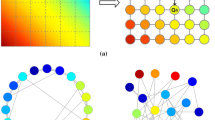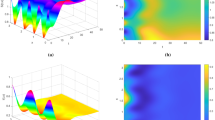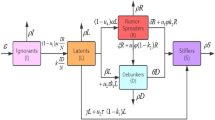Abstract
In the era of rapid development of the network, information security is a topic worthy of attention. This paper establishes a reaction–diffusion rumor propagation model with secondary transmission mechanism. We derive the necessary conditions for its Turing instability and then obtain that an increase in media refutation rate \(\gamma \) can effectively suppress rumors through sensitivity analysis. By converting the parameter \(\gamma \) to \(\gamma \left( \textbf{x},t\right) \) and using the Projected Gradient Method, rumors are controlled as the target propagation mode. By applying the method of optimal control, the parameter identification of the system is achieved through three algorithms. The Projected Gradient Method can effectively identify the patterns of two unknown parameters and has global convergence, but the convergence speed is relatively slow. The Barzilar-Borwein method and the BFGS Quasi-Newton Algorithm can effectively improve the convergence speed while ensuring the reliability of the results. The Barzilar-Borwein method is used to effectively identify six parameters of the system, with a relative error of only 0.3030\(\%\). Finally, by changing the parameter \(\gamma \) to a spatial heterogeneity parameter \(\gamma \left( \textbf{x}\right) \), we have achieved the reproduction of natural biological surface patterns through the Projected Gradient Method.
























Similar content being viewed by others
Data availability
Data sharing is not applicable to this article as no new data were created or analyzed in this study.
References
Hu, Y.H., Pan, Q.H., Hou, W.B., He, M.F.: Rumor spreading model with the different attitudes towards rumors. Phys. A 502, 331–344 (2018)
Li, C.R., Ma, Z.J.: Dynamics analysis and optimal control for a delayed rumor-spreading model. Mathematics 10, 3455 (2022)
Pan, W.Q., Yan, W.J., Hu, Y.H., He, R.M., Wu, L.B.: Dynamic analysis of a SIDRW rumor propagation model considering the effect of media reports and rumor refuters. Nonlinear Dyn. 111, 3925–3936 (2023)
Wang, J.L., Jiang, H.J., Ma, T.L.: C, Hu, Global dynamics of the multi-lingual SIR rumor spreading model with cross-transmitted mechanism. Chaos, Solitons Fractals 126, 148–157 (2019)
Li, J.L., Jiang, H.J., Yu, Z.Y., Hu, C.: Dynamical analysis of rumor spreading model in homogeneous complex networks. Appl. Math. Comput. 359, 374–385 (2019)
Zhu, L.H., Zhao, H.Y., Wang, H.Y.: Partial differential equation modeling of rumor propagation in complex networks with higher order of organization. Chaos 29, 053106 (2019)
Xia, Y., Jiang, H.J., Yu, Z.Y., Yu, S.Z., Luo, X.P.: Dynamic analysis and optimal control of a reaction-diffusion rumor propagation model in multi-lingual environments. J. Math. Anal. Appl. 521, 126967 (2023)
He, L., Zhu, L.H., Zhang, Z.D.: Turing instability induced by complex networks in a reaction-diffusion information propagation model. Inf. Sci. 578, 762–794 (2021)
Hu, J.L., Zhu, L.H.: Turing pattern analysis of a reaction-diffusion rumor propagation system with time delay in both network and non-network environments. Chaos, Solitons Fractals 153, 111542 (2021)
Ma, X.R., Shen, S.L., Zhu, L.H.: Complex dynamic analysis of a reaction-diffusion network information propagation model with non-smooth control. Inf. Sci. 622, 1141–1161 (2023)
Hu, J.L., Zhu, L.H., Peng, M.: Analysis of Turing patterns and amplitude equations in general forms under a reaction-diffusion rumor propagation system with Allee effect and time delay. Inf. Sci. 596, 501–519 (2022)
Zhao, H.Y., Zhu, L.H.: Dynamic analysis of a reaction-diffusion rumor propagation model. Int. J. Bifurc. Chaos 26, 1650101 (2016)
Zhu, L.H., Wang, X.W., Zhang, Z.D., Lei, C.X.: Spatial dynamics and optimization method for a rumor propagation model in both homogeneous and heterogeneous environment. Nonlinear Dyn. 105, 3791–3817 (2021)
Zhu, L.H., He, L.: Pattern formation in a reaction-diffusion rumor propagation system with Allee effect and time delay. Nonlinear Dyn. 107, 3041–3063 (2022)
Cheng, Y.Y., Huo, L.A., Zhao, L.J.: Stability analysis and optimal control of rumor spreading model under media coverage considering time delay and pulse vaccination. Chaos, Solitons Fractals 157, 111931 (2022)
Ding, L., Hu, P., Guan, Z.H., Li, T.: An efficient hybrid control strategy for restraining rumor spreading. IEEE Trans. Syst. Man, Cybern. Syst. 51, 6779–6791 (2021)
Chen, J., Yang, L.X., Yang, X.F., Tang, Y.Y.: Cost-effective anti-rumor message-pushing schemes. Phys. A 540, 123085 (2020)
Cheng, Y.Y., Huo, L.A., Zhao, L.J.: Dynamical behaviors and control measures of rumor-spreading model in consideration of the infected media and time delay. Inf. Sci. 564, 237–253 (2021)
Kandhway, K., Kuri, J.: Optimal control of information epidemics modeled as Maki Thompson rumors. Commun. Nonlinear Sci. Numer. Simul. 19, 4135–4147 (2014)
Yu, Y., Liu, J.M., Ren, J.D., Wang, Q., Xiao, C.Y.: Minimize the impact of rumors by optimizing the control of comments on the complex network. AIMS Math. 6, 6140–6159 (2021)
Zhu, L.H., Huang, X.Y., Liu, Y., Zhang, Z.D.: Spatiotemporal dynamics analysis and optimal control method for an SI reaction-diffusion propagation model. J. Math. Anal. Appl. 493, 124539 (2021)
Chang, L.L., Gong, W., Jin, Z., Sun, G.Q.: Sparse optimal control of pattern formations for an SIR reaction-diffusion epidemic model. SIAM J. Appl. Math. 82, 1764–1790 (2022)
Chang, L.L., Gao, S.P., Wang, Z.: Optimal control of pattern formations for an SIR reaction-diffusion epidemic model. J. Theor. Biol. 536, 111003 (2022)
Zhu, L.H., He, L.: Pattern dynamics analysis and parameter identification of time delay-driven rumor propagation model based on complex networks. Nonlinear Dyn. 110, 1935–1957 (2022)
Abram, M., Burghard, K., Steeg, G.V., Galstyan, A., Dingreville, R.: Inferring topological transitions in pattern-forming processes with self-supervised learning. NPJ Comput. Mater. 8, 205 (2022)
Zhu, L.H., He, L.: Two different approaches for parameter identification in a spatial-temporal rumor propagation model based on Turing patterns. Commun. Nonlinear Sci. Numer. Simul. 107, 106174 (2022)
Garvie, M.R., Trenchea, C.: Optimal control of a nutrient-phytoplankton- zooplankton-fish system. SIAM J. Control. Optim. 46, 775–791 (2007)
Garvie, M.R., Trenchea, C.: Identification of space-time distributed parameters in the Gierer-Meinhardt reaction-diffusion system. SIAM J. Appl. Math. 74, 147–166 (2014)
Garvie, M.R., Maini, P.K., Trenchea, C.: An efficient and robust numerical algorithm for estimating parameters in Turing systems. J. Comput. Phys. 229, 7058–7071 (2010)
Tröltzsch, F.: Optimal control of partial differential equations: theory, methods and applications. American Mathematical Society, Providence (2010)
Reyes, D.L., Carlos, J.: Numerical PDE-constrained optimization. Springer International Publishing, UK (2015)
Barzilai, J., Borwein, J.M.: Two-point step size gradient methods. IMA J. Numer. Anal. 8, 141–148 (1988)
Nocedal, J., Wright, S.J.: Numerical Optimization. Springer International Publishing (1999)
Broyden, C.G.: The convergence of a class of double-rank minimization algorithms. J. Inst. Math. Appl. 6, 76–90 (1970)
Fletcher, R., Reeves, C.M.: Function minimization by conjugate gradients. Comput. J. 7, 149–154 (1964)
Goldfarb, D., Shanno, D.: Convex programming in Hilbert space. Math. Oper. Res. 4, 381–404 (1970)
Shanno, D.F.: Conditioning of quasi-Newton methods for function minimization. Math. Comput. 24, 647–656 (1970)
Acknowledgements
This work was supported by National Natural Science Foundation of China (Grant No. 12002135), China Postdoctoral Science Foundation (Grant No. 2023M731382), Young Science and Technology Talents Lifting Project of Jiangsu Association for Science and Technology, College Students’ Innovative Entrepreneurial Training Plan Program (Grant No. 2022102991033X), and Scientific Research Project of Jiangsu University (Grant No. 21A304).
Funding
The authors have not disclosed any funding.
Author information
Authors and Affiliations
Contributions
LZ helped in conceptualization, formal analysis, and writing—original draft. TY was involved in data curation and writing—original draft.
Corresponding author
Ethics declarations
Conflict of interest
The authors have no conflicts to disclose in this paper.
Additional information
Publisher's Note
Springer Nature remains neutral with regard to jurisdictional claims in published maps and institutional affiliations.
Rights and permissions
Springer Nature or its licensor (e.g. a society or other partner) holds exclusive rights to this article under a publishing agreement with the author(s) or other rightsholder(s); author self-archiving of the accepted manuscript version of this article is solely governed by the terms of such publishing agreement and applicable law.
About this article
Cite this article
Zhu, L., Yuan, T. Optimal control and parameter identification of a reaction–diffusion network propagation model. Nonlinear Dyn 111, 21707–21733 (2023). https://doi.org/10.1007/s11071-023-08949-y
Received:
Accepted:
Published:
Issue Date:
DOI: https://doi.org/10.1007/s11071-023-08949-y




